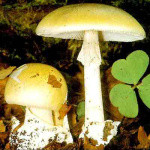Category: Other
Created by: Davide.Loi
Number of Blossarys: 2
Amanita Phalloides is a deadly poisonous Fungus. Commonly known as the Death Cap. Grows predominantly in hardwood or mixed woods, near oak, hornbeam, chestnut and hazel trees. This mushroom can be found between summer and autumn. The appearance is as follows: Cap: Fleshy, initially conical-trumpet or egg shaped but then flattening and even concave (diameter 9-15 cm). The color can vary, so in order to recognize and avoid it, you must to rely on other features, which are not just the color. The color of the cap may be: greenish, olive-green, ocher-yellowish. Sometimes brownish or whitish with green streaks. The lamellas are dense and white, sometimes with light greenish tinges. The stalk is cylindrical and slender. Full and then swollen or hollow. It can be white and feature silky or greenish ribbing. Bulbous at the base and wrapped in a large whitish membranous volva. The flesh is white or slightly colored under the cuticle of the cap. The odor is almost nonexistent in younger, unripe specimens. Old specimens have a fetid and sickly-sweet smell. The flavor is weak and sweet, acidic in adult specimens. Poisoning by Amanita Phalloide leads to death in 98% of cases (see fallopian syndrome).
L'Amanita Phalloides è un fungo Velenoso Mortale. Il suo nome volgare è Tignosa Verdognola. Cresce prevalentemente nei pressi di querce, carpini, castagni e noccioli, in boschi di latifoglie o misti. Il periodo in cui è possibile imbattersi in questo fungo va dall'estate all'autunno. All'aspetto si presenta come segue: Cappello: Carnoso, subito conico-campanulato o emisferico, quindi pianeggiante e anche concavo (diametro di 9-15 cm). Il colore può variare, quindi per riconoscerlo, ed evitarlo, bisogna affidarsi anche ad altre caratteristiche che non siano solamente quelle cromatiche. Il colore del cappello può infatti essere: verdastro, olivastro, verde-ocra-giallastro, talvolta bruno o biancastro con striature verdi. Le lamelle sono fitte e bianche, talvolta con leggeri riflessi verdastri. Il Gambo si presenta cilindrico e slanciato, pieno, poi farcito o cavo. Può essere bianco e presentare zigrinature sericee o verdastre. Bulboso alla base e avvolto da un'ampia volva membranosa biancastra. La carne è bianca o leggermente colorata sotto la cuticola del cappello. L'odore è quasi nullo negli esemplari più giovani, non ancora maturi, mentre è fetido e cadaverico in quelli più anziani. Il sapore è debole e dolciastro, più acido negli esemplari adulti. L'intossicazione da Amanita Phalloide porta alla morte nel 98 % dei casi (vedi sindrome fallodica).


 English (EN)
English (EN) 